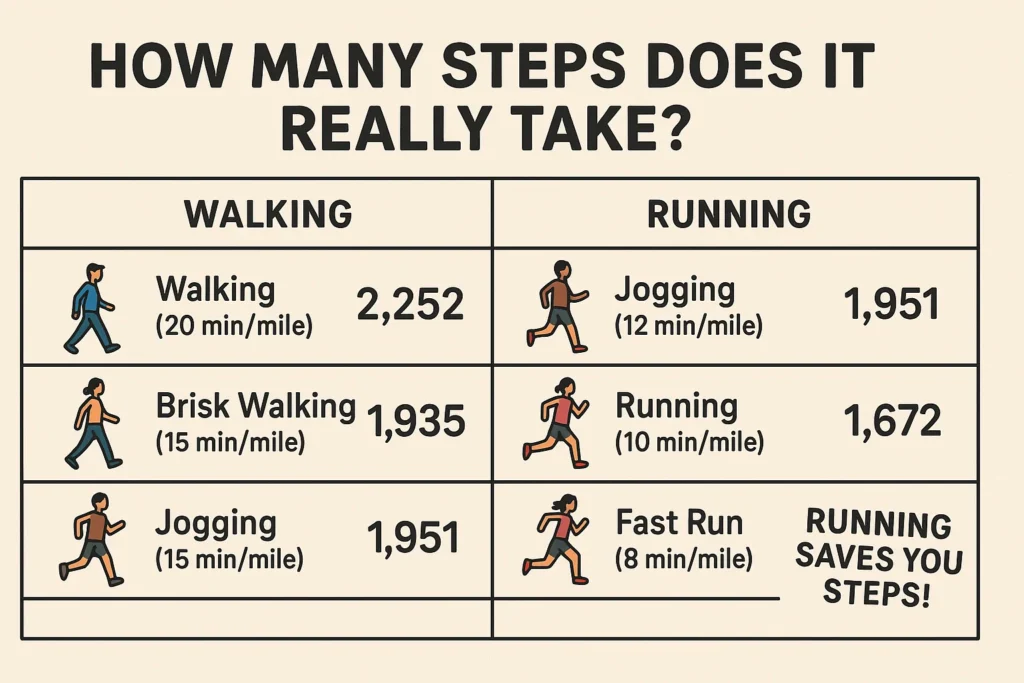
Are you trying to maximize your steps each day? Wondering if walking or running gets you further? The answer isn’t straightforward. Both activities offer unique benefits and contribute to a healthier lifestyle, but the number of steps you take depends on various factors like speed and distance. This article will delve into the differences between walking and running in terms of steps per mile and explore the health advantages each offers. We’ll also examine the factors that influence your step count, helping you make informed decisions about incorporating both activities into your fitness routine.
Walking vs Running Steps Per Mile
The age-old question: do you get more steps walking or running? Generally, running covers more ground faster than walking, resulting in fewer steps per mile. On average, a person takes approximately 2,000 steps per mile when walking at a moderate pace. However, when running, the step count drops to around 1,800 steps per mile. This difference arises because running involves longer strides and a faster cadence compared to walking.
It’s important to note that these figures can vary depending on individual stride length, speed, and terrain. For instance, walking uphill will naturally result in more steps than walking on flat ground. Similarly, a shorter, quicker run might lead to a higher step count than a longer, slower one.
Ultimately, the number of steps you take per mile depends on your personal pace and running style.
Health Benefits of Walking

Walking is a low-impact exercise that offers numerous health benefits for people of all ages and fitness levels. It’s an excellent way to improve cardiovascular health, strengthen bones and muscles, and manage weight.
Cardiovascular Health
Regular walking can help lower blood pressure, reduce cholesterol levels, and improve overall heart function. Walking also increases your heart rate, which helps strengthen your heart muscle and improves its ability to pump blood efficiently.
Weight Management
Walking burns calories, contributing to weight loss or maintenance. While it may not burn as many calories as running, consistent walking can still make a significant difference in your calorie expenditure over time.
Mental Well-being
Walking has been shown to reduce stress, anxiety, and symptoms of depression. Spending time outdoors while walking can also boost your mood and improve your overall sense of well-being.
Health Benefits of Running
Running is a high-impact exercise that provides even more intense cardiovascular benefits than walking. It burns more calories per hour and strengthens muscles at a faster rate.
Cardiovascular Fitness
Running elevates your heart rate significantly, leading to improved cardiovascular fitness and endurance. Regular running can strengthen your heart muscle, lower blood pressure, and improve cholesterol levels.
Bone Density
Running is a weight-bearing exercise that helps increase bone density, reducing the risk of osteoporosis and fractures. The impact forces from running stimulate bone growth and remodeling.
Muscle Development
Running engages multiple muscle groups throughout your body, particularly in your legs, core, and glutes. It builds strength and endurance in these muscles, improving overall athletic performance.
Factors Affecting Step Count

Several factors can influence the number of steps you take during walking or running:
- Speed: The faster you move, the fewer steps you’ll take per mile.
- Stride Length: Individuals with longer strides naturally cover more ground with each step.
- Terrain: Walking uphill requires more steps than walking on flat ground due to the increased effort required.
- Footwear: Proper footwear can affect your stride length and efficiency, potentially influencing your step count.
Conclusion
Both walking and running offer significant health benefits and contribute to an active lifestyle. While running generally leads to fewer steps per mile due to its higher speed and longer strides, both activities are valuable for improving cardiovascular health, strengthening muscles, and managing weight. Ultimately, the best choice for you depends on your individual fitness goals, preferences, and physical capabilities. Consider incorporating both walking and running into your routine for a well-rounded approach to exercise and overall well-being.
